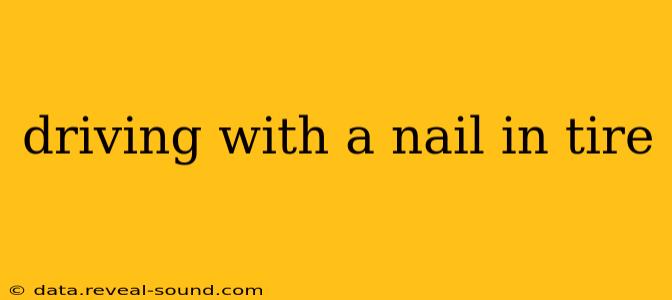Finding a nail in your tire is a frustrating experience, leaving you questioning whether you can continue driving or if immediate action is necessary. This comprehensive guide explores the risks associated with driving on a nail-punctured tire, outlines repair options, and offers preventative measures to minimize future occurrences.
Is it Safe to Drive with a Nail in My Tire?
This is the most pressing question for many drivers. The answer is: it depends. The severity of the situation hinges on several factors:
- Nail Location: A nail embedded in the tire's tread area might be manageable for a short distance, particularly if it's not causing significant air loss. However, a nail in the sidewall is extremely dangerous and requires immediate attention – driving on it could lead to a blowout.
- Air Loss Rate: A slow leak might allow you to drive cautiously to a tire shop, while rapid deflation poses an immediate safety hazard. Check your tire pressure regularly.
- Tire Condition: An already worn or damaged tire is far more susceptible to complete failure if a nail is present.
Never attempt to drive long distances or at high speeds with a nail in your tire. The risk of a blowout, which can lead to loss of control and accidents, is simply too high.
What Happens if You Drive with a Nail in Your Tire?
Driving on a nail-punctured tire, especially in the sidewall, can result in several dangerous scenarios:
- Blowout: The tire suddenly loses all its air pressure, causing a significant loss of control, potentially leading to an accident.
- Damage to the Wheel Rim: A complete blowout can also damage the wheel rim.
- Uneven Tire Wear: Driving on a low tire pressure causes uneven wear and tear, shortening the tire's lifespan.
- Further Damage to the Tire: The nail itself can cause further damage to the inner liner, making repair impossible.
How Do I Know if I Can Drive with a Nail in My Tire?
Assess the situation carefully. If you have a slow leak and the nail is in the tread, you might be able to drive cautiously to a nearby tire shop or garage. However, if you notice:
- Rapid deflation: Pull over immediately and change the tire or call for roadside assistance.
- Nail in the sidewall: Do not drive on it at all.
- Significant vibration or unusual sounds: These indicate more serious damage and necessitate immediate action.
Always err on the side of caution. Your safety and the safety of others are paramount.
Can a Nail in a Tire Be Repaired?
In some cases, yes. A nail in the tread area can often be repaired by a tire professional if it's not too close to the sidewall or shoulder. They will typically remove the nail, assess the damage, and plug or patch the hole, ensuring a proper seal to restore air pressure. A sidewall puncture is generally unrepairable and necessitates tire replacement.
How Can I Prevent Nails in My Tires?
While you can't completely eliminate the risk, there are steps you can take to minimize the chance of a nail puncture:
- Regular Tire Inspections: Regularly check your tires for any embedded objects, cuts, or bulges.
- Drive Carefully: Avoid driving over debris-strewn roads or areas with known hazards like construction zones.
- Maintain Proper Tire Pressure: Properly inflated tires are less susceptible to damage.
- Consider Tire Sealant: Some tire sealants can help prevent punctures by sealing small holes as they occur. However, this is not a substitute for regular tire maintenance.
What Should I Do If I Find a Nail in My Tire?
- Safety First: Pull over to a safe location away from traffic.
- Assess the Situation: Determine the location of the nail and the rate of air loss.
- Contact Roadside Assistance or a Tire Shop: If you're unsure, seek professional help.
- Do Not Attempt DIY Repairs Unless Experienced: Unless you have the necessary tools and expertise, do not attempt to repair the tire yourself.
By understanding the risks, repair options, and prevention strategies, you can significantly reduce the inconvenience and potential dangers of driving with a nail in your tire. Remember, prioritizing safety is always the best course of action.
